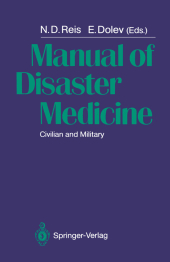 Neuerscheinungen 2011Stand: 2020-01-07 |
Schnellsuche
ISBN/Stichwort/Autor
|
Herderstraße 10
10625 Berlin
Tel.: 030 315 714 16
Fax 030 315 714 14
info@buchspektrum.de |

Eran Dolev, N. D. Reis
(Beteiligte)
Manual of Disaster Medicine
Civilian and Military
Herausgegeben von Reis, N.D.; Dolev, Eran
Softcover reprint of the original 1st ed. 1989. 2011. xiii, 475 S. 25 Tabellen. 205 mm
Verlag/Jahr: SPRINGER, BERLIN 2011
ISBN: 3-642-83442-6 (3642834426)
Neue ISBN: 978-3-642-83442-4 (9783642834424)
Preis und Lieferzeit: Bitte klicken
This book is not a learned treatise. Its purpose is to render practical instruction to all those physicians. surgeons, adminis trators, and paramedical personnel who have to act in war or disaster situations. As a manual it is in no way a substitute for existing detailed and specialized texts on the various aspects of trauma surgery and management: rather have we attempted to collate the most essenlial knowledge required to organize and afTord medical aid whenever civilian or military disaster strikes. The man on the spot is hardly ever a specialist, hence the need for a imple s general manual of instruction. The organizational aspects of medical services in war are very similar to those required for coping with a disaster: indeed the military are often called to cope with civilian disasters. Our duty is to be prepared, so as not to lose life and limb for lack of foresight. There are repetitions in the book for which no apologies are made, since they always concern invaluable knowledge. The chapters are organized to afford an understanding of the organization of medical services, the cause of wounds and trau matic disease, and the pathophysiological processes resulting from the different kinds of trauma. The management of treating casualties is divided in each section into the three basic eche lons: on site (at the actual place of wounding), at the medical (battalion) aid station and in the field or base hospital.
1 Organization of Medical Services.- 1.1 Organization of Military Health Support.- 1.2 Organization of Medical Services in Field.- 1.3 Organization of Medical Services in Disaster.- 1.4 Organization of Civil Hospitals During Sudden War/Mass Casualties.- 1.5.1 Organization of Civil Hospitals: Department of Radiology.- 1.5.2 Essential Clinical Laboratory Services.- 1.6 Equipment for Forward Casualty Care: The Battalion Medical Officer Kit.- 1.7 The Evacuation Hospital: Concept, Modes of Operation, and Organization.- 1.8 Aeromedical Services.- 2 Mechanisms/Causes of Injury: Pathophysiology and Management.- 2.1 Missile Wounds.- 2.2 Blast Injuries.- 2.3 Pathophysiology of Burn Injuries.- 2.4 Cold Injuries.- 2.5 Heatstroke and Heat Exhaustion.- 2.6 Immersion Hypothermia.- 2.7 Near Drowning.- 2.8 Crush Injuries and Crush Syndrome.- 2.9 Chemical Warfare and Disasters: Medical Organization and Treatment.- 2.10 Medical Aspects of Thermonuclear Disaster.- 2.11 Hyperbaric Medicine.- 2.12 Infections in the Wounded.- 2.13 Combat Stress Reaction.- 3 Treatment of Wounds: General.- 3.1 Trauma Scoring.- 3.2 Mass Casualties and Triage.- 3.3 Multiple Injuries.- 3.4 The Physiological Metabolic Response of the Body to Injury.- 3.5 Posttraumatic Shock.- 3.6 Primary Treatment of the Wounded: On-Site and Medical Aid Station.- 3.7 Primary Care of Burn Victims.- 3.8 Treatment of Burns in Hospital.- 3.9 Radiology in the Management of Wounds.- 3.10 Anesthesiology, Monitoring, and Intensive Care.- 3.11 Wounds of Soft Tissues and Limbs.- 3.12 Injuries to the Bones and Joints.- 3.13 Amputations.- 3.14 Peripheral Nerve Injuries.- 4 Treatment of Wounds: Regional.- 4.1 Head Injuries.- 4.2 Spinal Injuries.- 4.3 Spinal Cord Injury.- 4.4 Maxillofacial Wounds.- 4.5 Eye Injury.- 4.6.1 Ear, Nose, Throat and Neck Injury: Part I.- 4.6.2 Ear, Nose, Throat and Neck Injury: Part II.- 4.7 Cardiovascular Injury.- 4.8 Thoracic Injuries.- 4.9 Management of Abdominal Injuries.- 4.10 Genitourinary Wounds.- 4.11 Wounds of the Hand.


